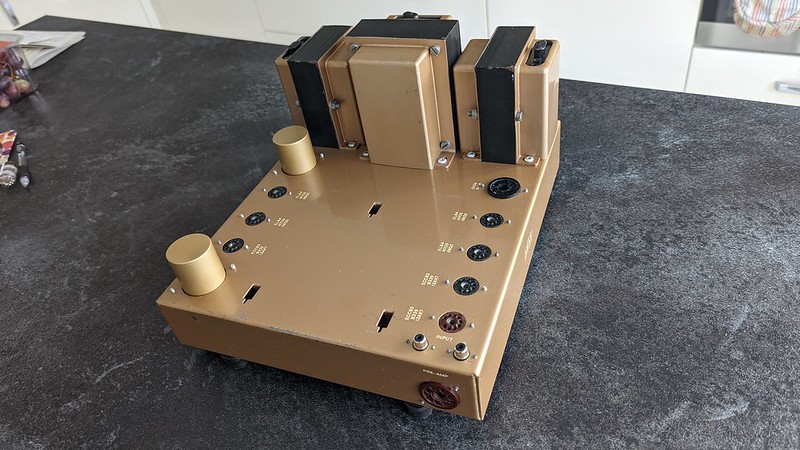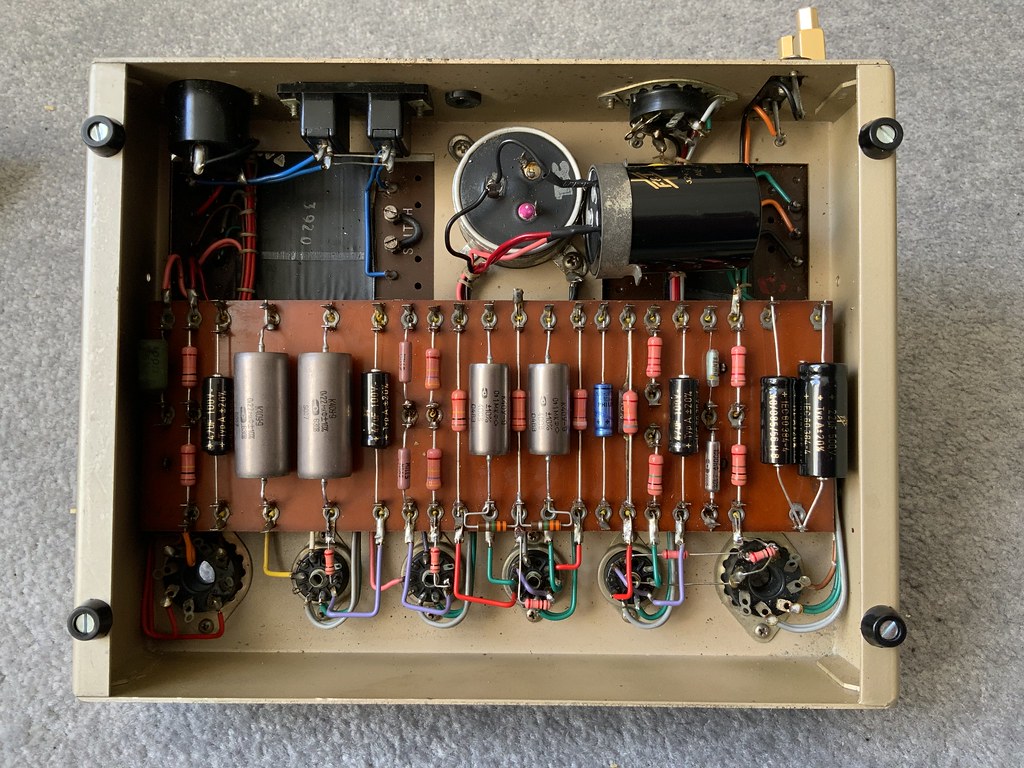Can anyone advise please whether it is potentially harmful / dangerous to one's health to 'skin' a capacitor so that the aluminium body can can be painted? I'm replacing the two caps that stick out of the deck of my Leak 20 so that I can paint them to match the colour of the chassis. However, the plastic cover of a capacitor acts as an insulator and I wonder therefore whether this is a safe thing to do. I know others have indeed done this but surely DC voltage builds up inside the capacitor?
You are using an out of date browser. It may not display this or other websites correctly.
You should upgrade or use an alternative browser.
You should upgrade or use an alternative browser.
Leak Stereo 20 - skinning capacitors
- Thread starter Oily Rag
- Start date
In theory, the can is well insulated from any voltage but I wouldn't do for safety reasons. Electrolytic caps do wear out and occasionally go pop releasing their acidic electrolyte so it's just better to stay safe as you've got most of 400v inside the cap. Can you not paint the plastic or mount some aly cans over the caps?
Tony L
Administrator
The casework of the Stereo 20 is mains earth. The whole chassis is grounded. The case of the capacitor is therefore connected to mains earth. It is perfectly safe. There is no voltage on the capacitor casing at all. The original Leak capacitors were only painted, no plastic insulator. If you use a high quality modern equivalent, F&T etc, there is no issue It is arguably far safer as any fault condition in the capacitor couldn’t go to the case as it is grounded to mains earth. Just make sure the amp is correctly fused and it will work as designed.
PS The only place you would ever see a voltage on a capacitor casing is in certain areas of the high voltage section of old Tektronix scopes etc which run at an ‘elevated potential’ (I think that is the right term) where effectively the ground is raised to a voltage to enable a higher working voltage overall. All well over my pay grade, but the Stereo 20 chassis is certainly safe if wired-up as designed.
PS The only place you would ever see a voltage on a capacitor casing is in certain areas of the high voltage section of old Tektronix scopes etc which run at an ‘elevated potential’ (I think that is the right term) where effectively the ground is raised to a voltage to enable a higher working voltage overall. All well over my pay grade, but the Stereo 20 chassis is certainly safe if wired-up as designed.
Have you been listening with fingers in your ears by any chance?
The USB interface presents as four channel. In Linux, you would use the plughw: device rather than hw: - look for something along those lines
Are you transformer or capacitor coupled?
True in theory the case is earthed but any fault condition in the earthing could leave the case at a high voltage so the plastic is extra protection. It's your amp, your house insurance, your choice.........The casework of the Stereo 20 is mains earth. The whole chassis is grounded. The case of the capacitor is therefore connected to mains earth. It is perfectly safe. There is no voltage on the capacitor casing at all. The original Leak capacitors were only painted, no plastic insulator. If you use a high quality modern equivalent, F&T etc, there is no issue It is arguably far safer as any fault condition in the capacitor couldn’t go to the case as it is grounded to mains earth. Just make sure the amp is correctly fused and it will work as designed.
PS The only place you would ever see a voltage on a capacitor casing is in certain areas of the high voltage section of old Tektronix scopes etc which run at an ‘elevated potential’ (I think that is the right term) where effectively the ground is raised to a voltage to enable a higher working voltage overall. All well over my pay grade, but the Stereo 20 chassis is certainly safe if wired-up as designed.
I appreciate both replies. In the first instance I shall attempt to find some appropriately sized ally sleeves that will slip over the exposed caps that I can paint and I'll leave the plastic cover on. If I can't find such a thing, like Tony says, the original caps were exposed and simply painted.
chiily
PFM Special Builder
I've done the same for my rebuild of a ST20 without any problems. I skinned them, etched primed them and a couple of passes with a colour close to the Leak's chassis.Can anyone advise please whether it is potentially harmful / dangerous to one's health to 'skin' a capacitor so that the aluminium body can can be painted? I'm replacing the two caps that stick out of the deck of my Leak 20 so that I can paint them to match the colour of the chassis. However, the plastic cover of a capacitor acts as an insulator and I wonder therefore whether this is a safe thing to do. I know others have indeed done this but surely DC voltage builds up inside the capacitor?
 PXL_20220402_152157600~2 by Garf Arf, on Flickr
PXL_20220402_152157600~2 by Garf Arf, on Flickr PXL_20220420_161333133 by Garf Arf, on Flickr
PXL_20220420_161333133 by Garf Arf, on Flickr 2023-08-23_05-53-51 by Garf Arf, on Flickr
2023-08-23_05-53-51 by Garf Arf, on FlickrTony L
Administrator
The alternative is to leave the original caps in place but disconnected for cosmetics, and strap new ones underneath. This was my approach with the TL12 Plus monos:

It is rigidly bolted to the bracket that holds the now dormant original. I can’t remember what room is like in the Stereo 20, but I have seen people stick a pair of modern caps under the originals. I took this approach with the TL12 Plus as I didn’t have the confidence or tools to empty the original caps and there is no modern equivalent anything like the right size (the TL12 cap is huge). Spoils the look underneath, but no one sees that, plus mine have metal baseplates on now anyway. It was non-destructive and it worked!

It is rigidly bolted to the bracket that holds the now dormant original. I can’t remember what room is like in the Stereo 20, but I have seen people stick a pair of modern caps under the originals. I took this approach with the TL12 Plus as I didn’t have the confidence or tools to empty the original caps and there is no modern equivalent anything like the right size (the TL12 cap is huge). Spoils the look underneath, but no one sees that, plus mine have metal baseplates on now anyway. It was non-destructive and it worked!
The existing capacitors in my unit are modern LCR, which are perfectly fine sonically, it's just that they are blue .......... and blue and gold / bronze don't really go together in my eyes. Blue and gold / bronze are opposites on the colour wheel, which is supposed therefore to add 'energy' to the visage, however, since the only energy I want is inside the capacitor, the colour needs to be complementary. I could have skinned and painted the LCR's but I've bought some higher capacity Mundorf caps that are coated with black plastic; it's mainly for cosmetic purposes that I'm changing them. I like the idea of fabricating sleeves from 40 dia. aluminium tube with one end capped off by some means. I've already purchased the paint for which I chose the VW La1V colour, which I hope is a close match to the chassis. I'm aiming to get my unit to the high standards achieved by some of the excellent Leak 20 restorations I've seen on here, and elsewhere on the web. It's close now but just needs a bit of fettling; and you can't beat a good fettle.
chiily
PFM Special Builder
What uF capacity are the cap you've bought? There is a maximum size that the GZ34 rectifier can cope with, about 60uF from the GZ34's data sheet.The existing capacitors in my unit are modern LCR, which are perfectly fine sonically, it's just that they are blue .......... and blue and gold / bronze don't really go together in my eyes. Blue and gold / bronze are opposites on the colour wheel, which is supposed therefore to add 'energy' to the visage, however, since the only energy I want is inside the capacitor, the colour needs to be complementary. I could have skinned and painted the LCR's but I've bought some higher capacity Mundorf caps that are coated with black plastic; it's mainly for cosmetic purposes that I'm changing them. I like the idea of fabricating sleeves from 40 dia. aluminium tube with one end capped off by some means. I've already purchased the paint for which I chose the VW La1V colour, which I hope is a close match to the chassis. I'm aiming to get my unit to the high standards achieved by some of the excellent Leak 20 restorations I've seen on here, and elsewhere on the web. It's close now but just needs a bit of fettling; and you can't beat a good fettle.



